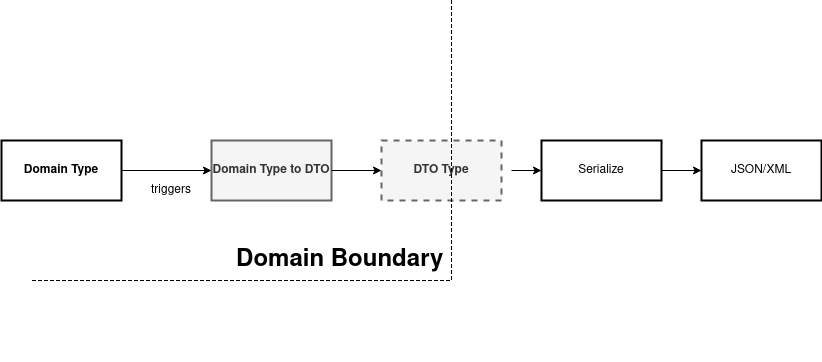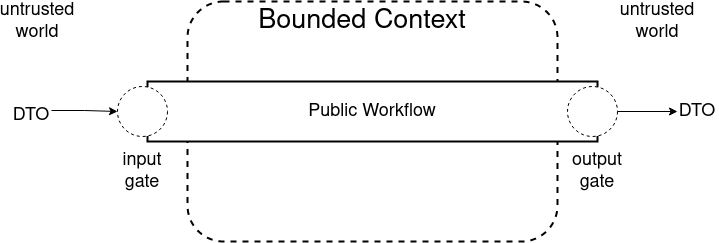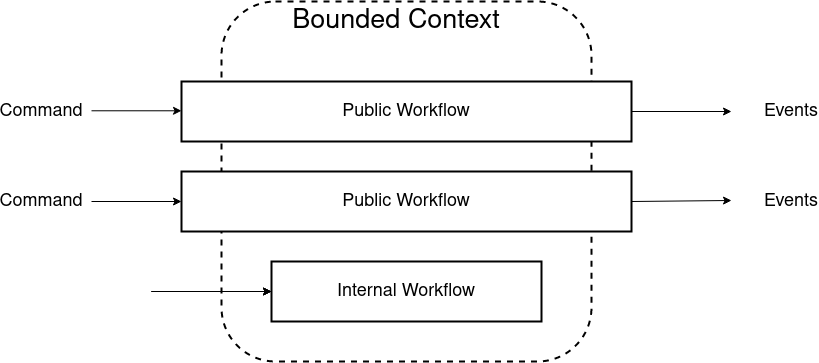Domain Modeling Made Functional #3: A Functional Architecture
Posted on September 13, 2022
Here we lay out how to translate the domain we laid out into actual software.
We borrown the terminology from Simon Brown's C4 approach. In this approach software architecture consists of four parts:
- the system context is a a top level, representing the entire system and consists of number of containers,
- the container is a deployable unit such as a website, a web service, a database, etc.,
- many components can make up a container (not sure what it is exactly),
- many modules/classes make up a component.
Bounded Contexts as Autonomous Software Components
If we have a monolith system, i.e., everything is in a single container and deployable just on its own, a bounded context could be a simple module with a well defined public interface. On the other hand each bounded context could be a separate C4 container making it a service oriented architecture. We could go even deeper and present each workflow as a separate C4 container and makie it a microservice oriented achitecture. It is all up to us. What is important is boundaries.
Communicating Betweem Bounded Contextsare
Bounded contexts communicate with each other through events only. The implementation that handles the communiqation could be a messaging queue or something else. The handler that translated events to commands could live on the boundary of the context.
It could also be done by a separate message router or process manager
Transferring Data Between Bounded Contexts
The data (domain objects) that we transfer inside events between bounded
context might look identical to events but in reality it is not the same. This
data is specifaclly designed to be serialized and shared as a part on
interconnected infrastructure. These object are called Data Transfer
Objects or DTOs in short. In short inside a UserRegisteredDTO DTO
there will be almost the same data as in UserRegistered event but it will
be structured differently to suit its purpose.


Trust Boundaries and Validation
The perimeter of a bounded context acts as a "trust boundary". Anything inside a context must be valid. Anything outside of it must ba validated.

At the input gate we always validate the input, things like non-null, etc. If such validation fails then the workflow is bypassed and error is generated. The job of the output gate is to ensure that private information is not leaked.
Contracts Between Bounded Contexts
We strive to reduce copling between contexts as much as possible but we cannot remove it completely as they in the end work together. This coupling is decided by a contract and who defines the contract depends.
- Shared Kernel - a relationship in which two contexts share some common domain, so the teams must collaborate.
- Customer/Supplier (Consumer Driven Contract) - downstream context defines the contract, that the upstream context must adhere to.
- Conformist - Upstream defines the contract for the downstream.
Anti-Corruption Layers
Sometimes when we communicate with external systems the do not fit at all into our domain. For these we create ACLs that translate data into valid objects in our domains. This happens at the gates.
Workflows Within a Bounded Context
Workflow in the and is a single function that takes command object as input and the output is a list of object events.

A worfklow is always contained within a single bounded context.
If a contract between two bounded context is consumer driven then rather than sending a generic event we would probably have a more specific event defined fo the consuming context.
Workflow does not publish any events, it simply returns them!
Avoid Domain Events Within a Bounded Context
We should not be listening for event coming from the same bounded context. It is better to instead just append what handler would to at the end of the workflow. This mitigates hidden dependencies that can come up.
Code Structure Within a Bouded Context
Use onion archtiecture! The domain should be at the center, and each outside layer can only depend on the inner layers. The domain should be at the center, and each outside layer can only depend on the inner layers.
For example domain layer being at the center, can be a dependency of a service layer, which the can be a dependency of API, infrastructure and database layers. To do that use dependency injection.
Keep I/O at the edges
In functional approach we want to work with pure functions and keep the impire ones at the edges of the architecture. All functions should have explicit dependencies instead of hidden dependencies (like accessing a database inside a workflow should no come from some global function but rather be injected through a parameter). For example read from database at the beginning of a workflow, not inside it.